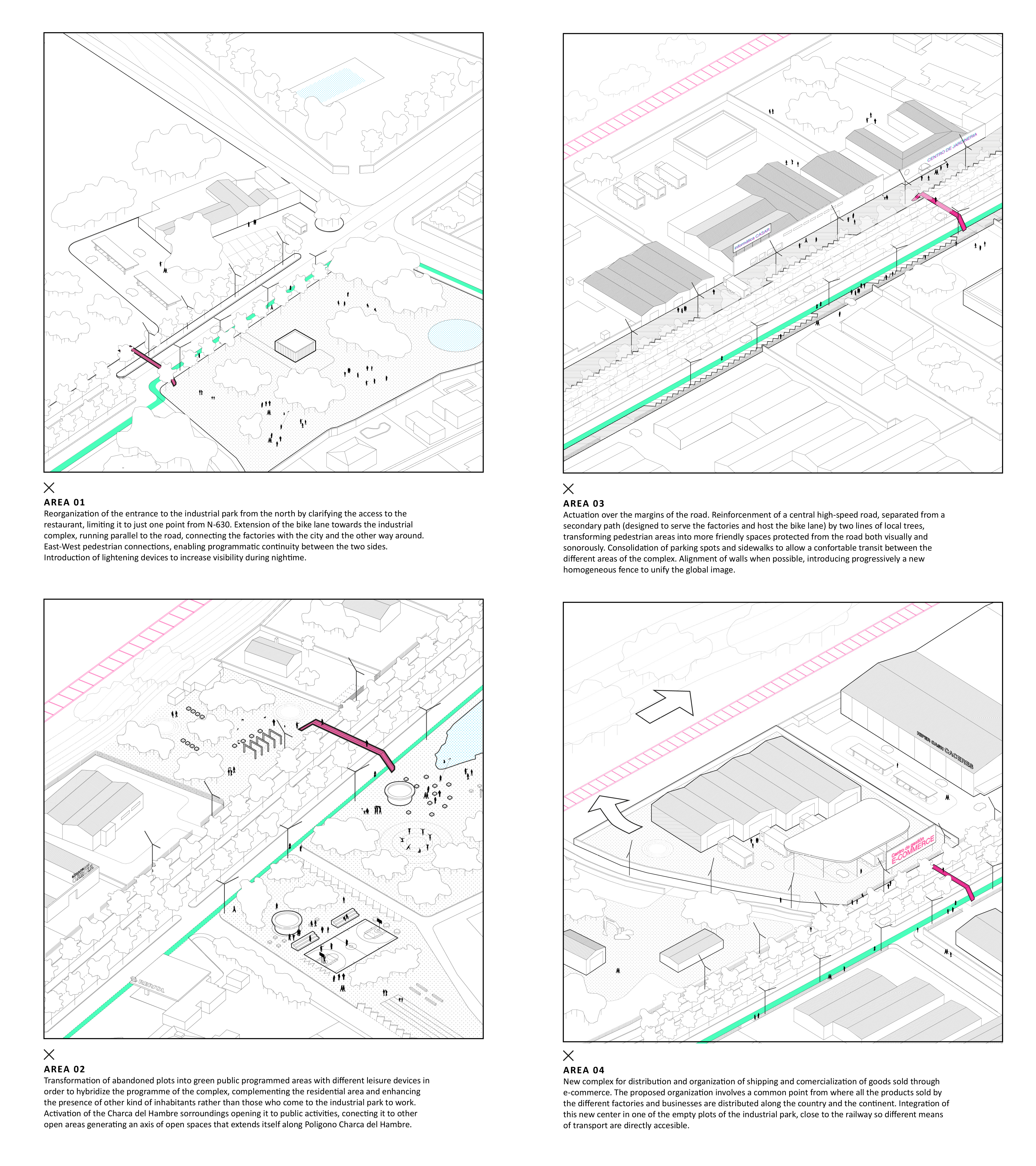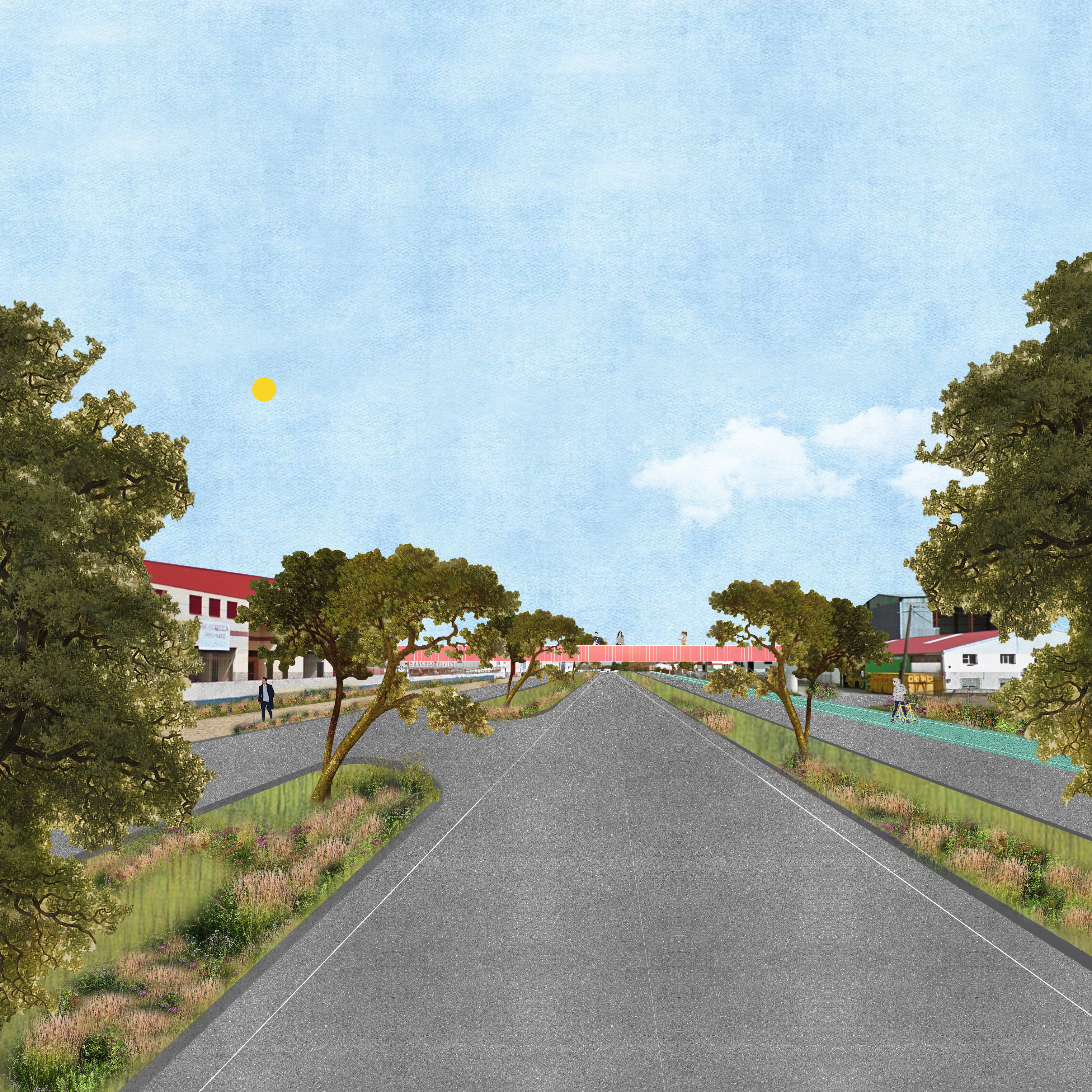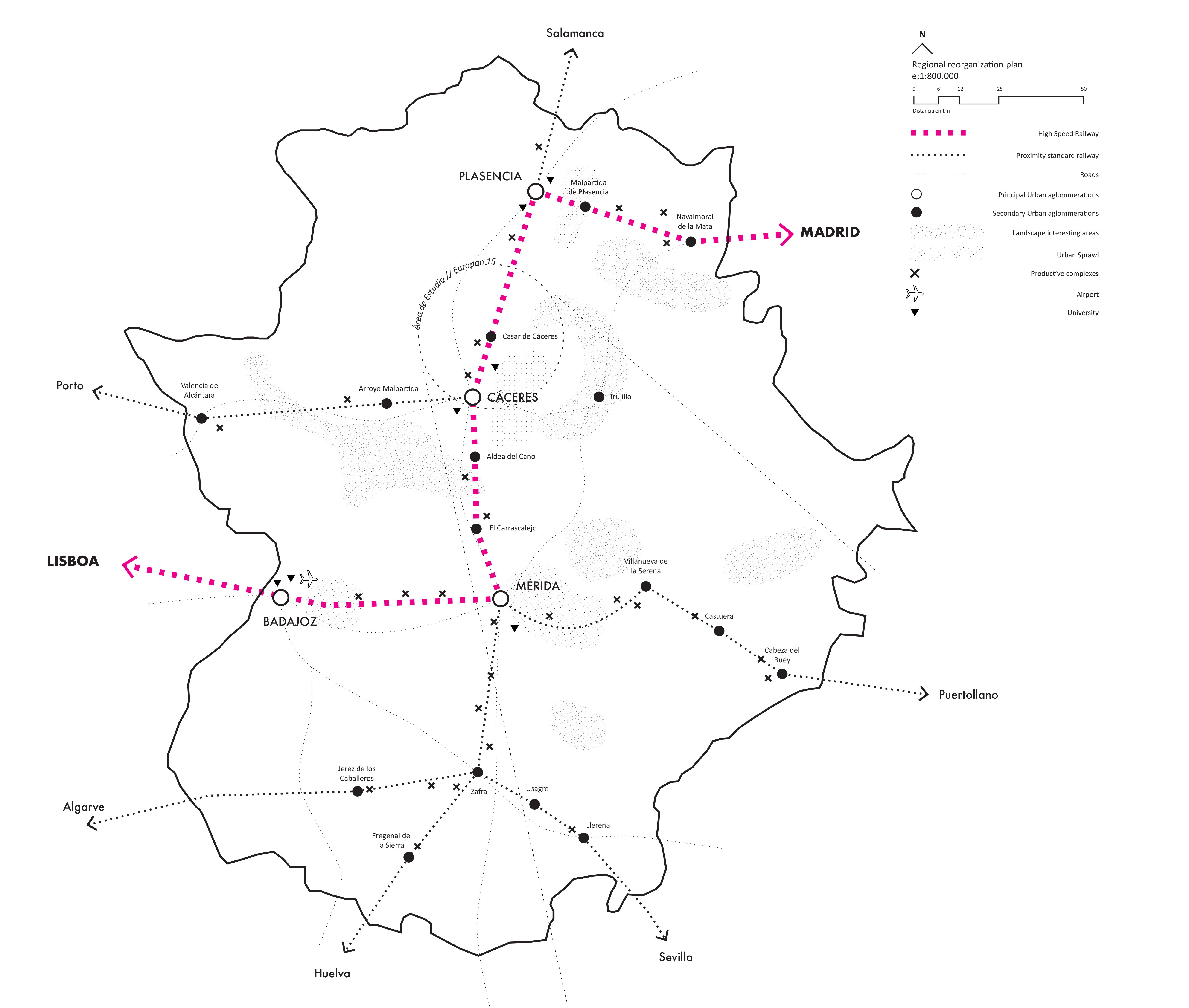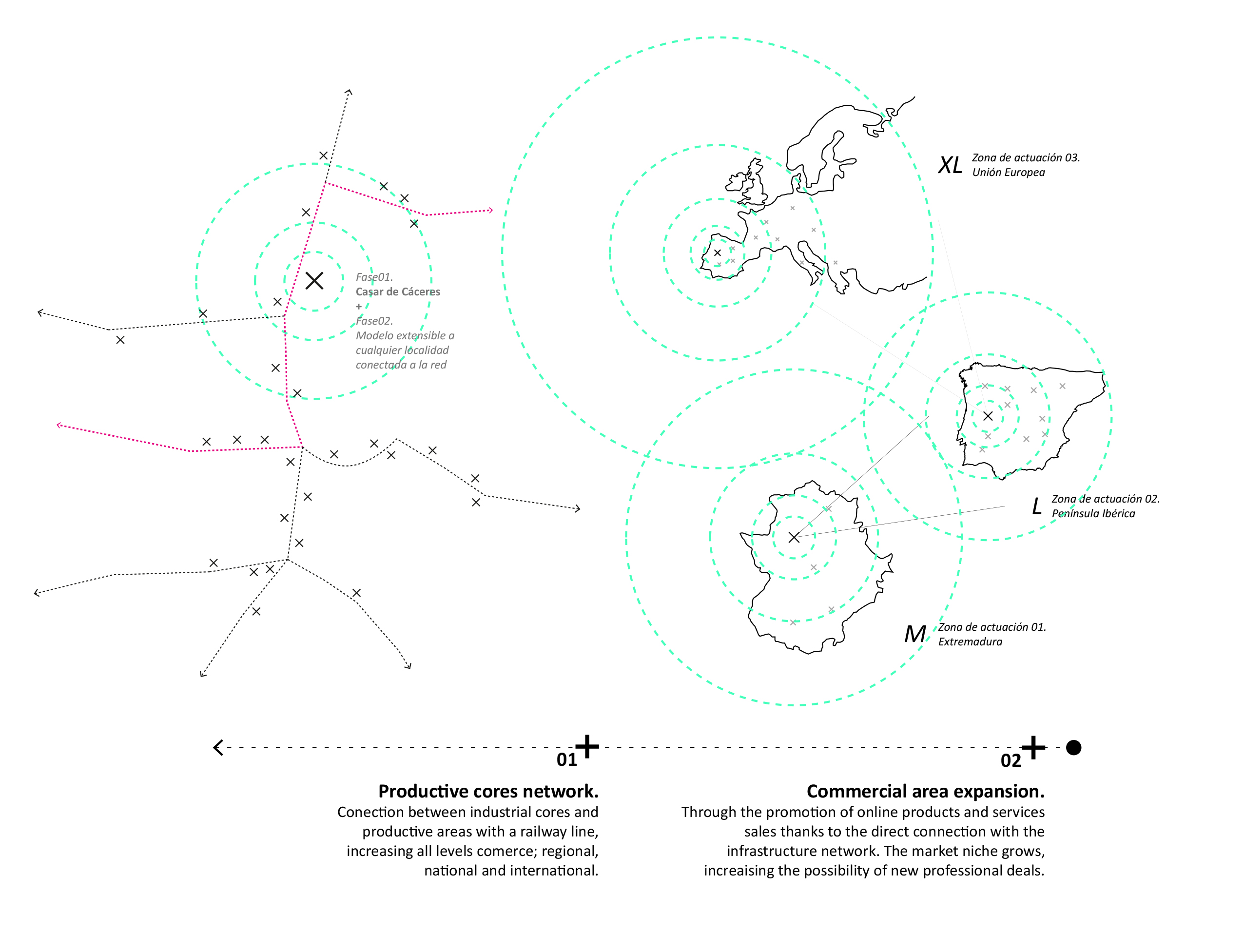




+
Casar de Cáceres, E-Village
Casar de Cáceres, Extremadura, Spain
Europan 15, Productive Cities ft. Ángela Molina
2019
How to deal with depoblation?
According to Spain’s ministry for territorial policy, 90% of the country’s population (about 42 million people) is packed into 1,500 towns and cities that occupy 30% of the land. The other 10% (4.6 million people) occupy the remaining 70%, giving a population density of barely 14 inhabitants per square kilometre. Over the past eight years, 80% of Spanish municipalities have experienced population falls. For decades there’s been a lack of interest from governments and investment in urban policies, infrastructure improvements and space requalification go to cities and villages where there are more people. Normally this abandom villages are not far from important cities but the lack of quialified communication between them end up in creating an invisible barrier and isolating those empty villages. This reality also affect younger generations having to leave this villages as the municipality have nothing to offer them to stay. This new generations have to go to other municipalities where finding a proper job is possible and made ther lives there. This small villages live from small industries and barely from the primary sector that is surviving thanks to this situation. There are local industries of a huge variety of sectors but whose working conditions are far from what can be found in bigger cities and villages. As no money is invested this local business lack technology implementations and workers conditions are obsolete.
Spain has one of the highest youth unemployment rates in Europe, and where one out of every five youths neither works nor studies. The country also has the highest proportion of 15-to-24-year-olds who are forced to accept part-time contracts and whose working conditions are far from what is exoected.A young Spaniard takes an average six years to find a permanent position, compared with two years in Denmark. Nearly 71 percent of young workers in Spain are on temporary contracts, and that rate has grown during the economic crisis. Having this situation in the country it is common to accept slabish contracts with long working hours and bad laboral conditions. This young generation also include young professionals that after compliting a degree or a master try to find a job where there expectations are filled but end up working in fields that have nothing to do with their studies. With this reality it is common to see many of this overquialified professionals leaving the country and making their lives in other parts of the world where their professional status is admired and valorated. Surveys indicate that in this moment unemployment rates have been reduced but this reality is not completely sure as average salary have been reduced in order to increase emplyment and justify this fake reality.
![]()
![]()
![]() I. Empty suburbs and excesive centralization.
I. Empty suburbs and excesive centralization.
The locality of Casar de Caceres and the Extremadura region as a hole is suffering a progressive depoblation process that not only affects the urban exodus from small villages to bigger cities of the region but also an exodus to the main central cities of the country what end up in complete rerritoral regions suffering from depopulation. Non-updated productive methods together with an obsolete communication infrastructure and the lack of new employment opportunities forces the community to abandon this region. Having this situation as a base, a new approach to transform this dynamics is proposed in order to reverse this negative dynamics by the integration of their strenghts points. How could it be possible to transform Casar de Caceres into an appealing spot for younger generations who wat to abandon bigger cities? Creating a direct link between the highly educated professionals and the local and regional industries will promote mutual advantage, while this profesionals receive new employment opportunities the others regenerate their production.
II. Territorial infrastructure solutions for local matters.
The productive structure in the Extremadura region is generated by the configuration of a communication network based on the railway and road transport which is in some specific points interrupted by industrial hubs and productive complexes. The progressive deterioration that this communication network have suffered and the lack of continuity and preservation of this areas have reduce the effectiveness of the oscilation of either local community and goods and have also created a strong barrier between this regions and the rest of the county. As a starting point it is neccesary for stablishing new strong poblational settlements the recuperation of the transport regional infrastructure. This structure facilitates the territorial communication, allowing new capital inflows, new working opportunities and the integration of the productive hubs in a new effective communication network.
III. Microinterventions to put the territory together.
At an urban level, a catalogue of different strategies is proposed to upgrade the quality of the connection between Polígono Charca del Hambre and the city. Regarding mobility systems the project adresses the possibility of completing the bike lane, through a continuous ring that ties together the industrial park, the housing area and the town. From a landscape point of view the extension of these bike paths through the territory is foreseen, including the existing dirt roads in the network, so the different points of interest of the area can be visited without the need of using a car. Through this strategies to improve the accesibility of the territory and the implementation of different viewpoints or sightseeing towers it is pretended to promote the valorization of the “charcas” and “dehesas” as key elements of the image of the region. The last idea is to guarantee an adequate access and connection between the transport network and Polígono Casar de Cáceres, both with railways and roads, enabling a quick and effective access to goods and products making it easier to buy and sell. The image of the complex will be modified looking for a more homogeneous aspect, as well as making it more friendly and inhabitable for the agents that currently operate within the area.
Casar de Cáceres, E-Village
Casar de Cáceres, Extremadura, Spain
Europan 15, Productive Cities ft. Ángela Molina
2019
How to deal with depoblation?
According to Spain’s ministry for territorial policy, 90% of the country’s population (about 42 million people) is packed into 1,500 towns and cities that occupy 30% of the land. The other 10% (4.6 million people) occupy the remaining 70%, giving a population density of barely 14 inhabitants per square kilometre. Over the past eight years, 80% of Spanish municipalities have experienced population falls. For decades there’s been a lack of interest from governments and investment in urban policies, infrastructure improvements and space requalification go to cities and villages where there are more people. Normally this abandom villages are not far from important cities but the lack of quialified communication between them end up in creating an invisible barrier and isolating those empty villages. This reality also affect younger generations having to leave this villages as the municipality have nothing to offer them to stay. This new generations have to go to other municipalities where finding a proper job is possible and made ther lives there. This small villages live from small industries and barely from the primary sector that is surviving thanks to this situation. There are local industries of a huge variety of sectors but whose working conditions are far from what can be found in bigger cities and villages. As no money is invested this local business lack technology implementations and workers conditions are obsolete.
Spain has one of the highest youth unemployment rates in Europe, and where one out of every five youths neither works nor studies. The country also has the highest proportion of 15-to-24-year-olds who are forced to accept part-time contracts and whose working conditions are far from what is exoected.A young Spaniard takes an average six years to find a permanent position, compared with two years in Denmark. Nearly 71 percent of young workers in Spain are on temporary contracts, and that rate has grown during the economic crisis. Having this situation in the country it is common to accept slabish contracts with long working hours and bad laboral conditions. This young generation also include young professionals that after compliting a degree or a master try to find a job where there expectations are filled but end up working in fields that have nothing to do with their studies. With this reality it is common to see many of this overquialified professionals leaving the country and making their lives in other parts of the world where their professional status is admired and valorated. Surveys indicate that in this moment unemployment rates have been reduced but this reality is not completely sure as average salary have been reduced in order to increase emplyment and justify this fake reality.


 I. Empty suburbs and excesive centralization.
I. Empty suburbs and excesive centralization.
The locality of Casar de Caceres and the Extremadura region as a hole is suffering a progressive depoblation process that not only affects the urban exodus from small villages to bigger cities of the region but also an exodus to the main central cities of the country what end up in complete rerritoral regions suffering from depopulation. Non-updated productive methods together with an obsolete communication infrastructure and the lack of new employment opportunities forces the community to abandon this region. Having this situation as a base, a new approach to transform this dynamics is proposed in order to reverse this negative dynamics by the integration of their strenghts points. How could it be possible to transform Casar de Caceres into an appealing spot for younger generations who wat to abandon bigger cities? Creating a direct link between the highly educated professionals and the local and regional industries will promote mutual advantage, while this profesionals receive new employment opportunities the others regenerate their production.
II. Territorial infrastructure solutions for local matters.
The productive structure in the Extremadura region is generated by the configuration of a communication network based on the railway and road transport which is in some specific points interrupted by industrial hubs and productive complexes. The progressive deterioration that this communication network have suffered and the lack of continuity and preservation of this areas have reduce the effectiveness of the oscilation of either local community and goods and have also created a strong barrier between this regions and the rest of the county. As a starting point it is neccesary for stablishing new strong poblational settlements the recuperation of the transport regional infrastructure. This structure facilitates the territorial communication, allowing new capital inflows, new working opportunities and the integration of the productive hubs in a new effective communication network.
III. Microinterventions to put the territory together.
At an urban level, a catalogue of different strategies is proposed to upgrade the quality of the connection between Polígono Charca del Hambre and the city. Regarding mobility systems the project adresses the possibility of completing the bike lane, through a continuous ring that ties together the industrial park, the housing area and the town. From a landscape point of view the extension of these bike paths through the territory is foreseen, including the existing dirt roads in the network, so the different points of interest of the area can be visited without the need of using a car. Through this strategies to improve the accesibility of the territory and the implementation of different viewpoints or sightseeing towers it is pretended to promote the valorization of the “charcas” and “dehesas” as key elements of the image of the region. The last idea is to guarantee an adequate access and connection between the transport network and Polígono Casar de Cáceres, both with railways and roads, enabling a quick and effective access to goods and products making it easier to buy and sell. The image of the complex will be modified looking for a more homogeneous aspect, as well as making it more friendly and inhabitable for the agents that currently operate within the area.